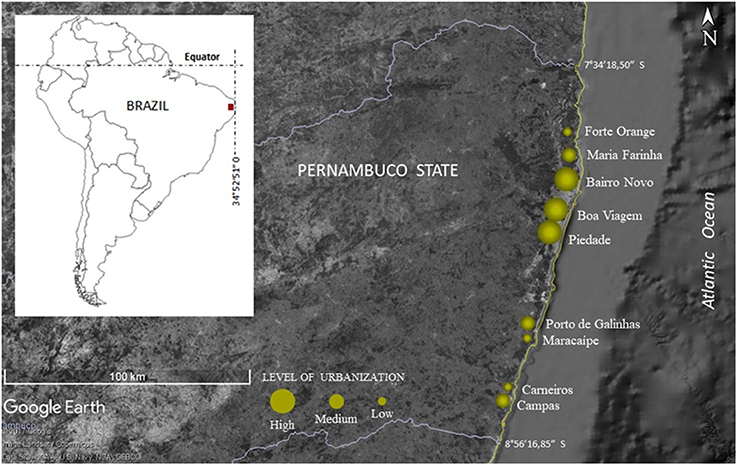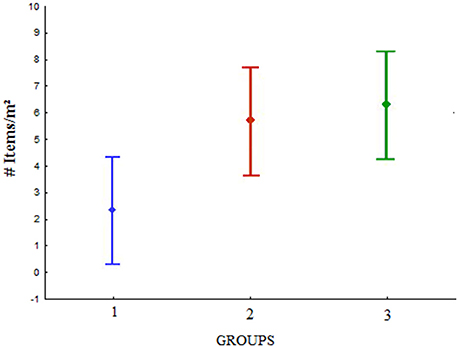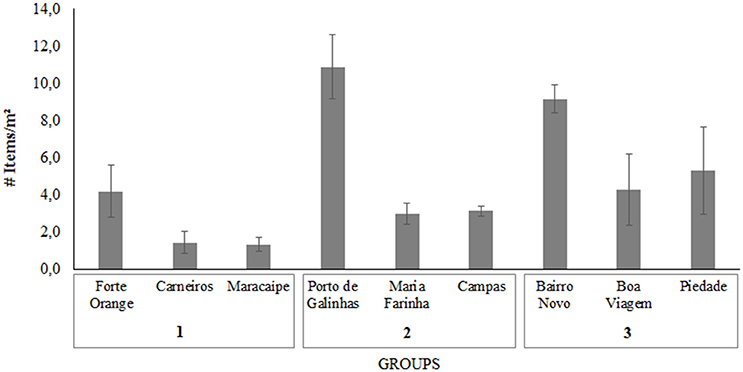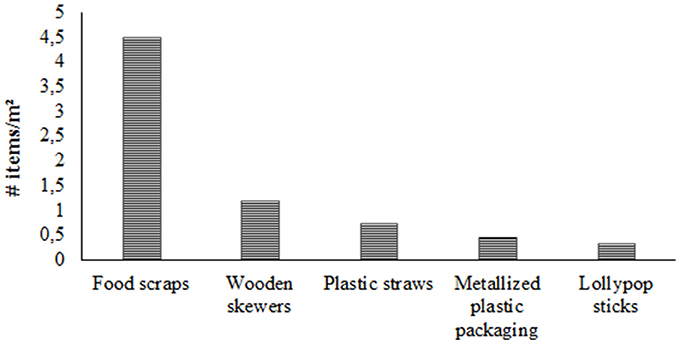- 1Departamento de Oceanografia e Limnologia, Universidade Federal do Rio Grande do Norte, Natal, Brazil
- 2Unidade Acadêmica do Cabo de Sto Agostinho, Universidade Federal Rural de Pernambuco, Recife, Brazil
- 3Departamento de Oceanografia, Universidade Federal de Pernambuco, Recife, Brazil
This research aimed to evaluate anthropogenic litter found on beaches with different levels of development and use along the coast of Pernambuco (northeast Brazil) to determine patterns in composition and origin. The study was conducted in January 2013 at nine beaches classified into three groups according to the level of urbanization. At each beach, three sections measuring 100 m long and 1 m wide were defined along the high-tide waterline where all items of anthropogenic litter larger than 2 cm were visually counted and classified. The sections were separated by intervals of 100 m. Within each 100 m section, random stretches of 10 m were selected where all the visible plastic fragments with sizes between 0.5 and 2 cm were collected and bagged for subsequent counting. Sources of anthropogenic litter were divided into three categories, namely beach users, land-based (houses/residences), mixed, and fisheries. A total of 12,815 items were found on the nine beaches within the three transects on each beach (one survey per beach), with densities (items/m2) of 2.3, 5.7, and 6.3 for groups 1, 2, and 3, respectively. The most-represented items of anthropogenic litter in the evaluated samples were plastic, food scraps, and wood (wooden skewers). With respect to items composed of plastic, the majority were cigarette butts (45%). Additionally, cigarette butts made up 26% of all anthropogenic litter samples collected. A larger amount of fragments smaller than 2 cm occurred in all beaches; for this size fraction, the densities were 0.6, 0.5, and 0.76 items/m2 for groups 1, 2, and 3, respectively, which were 1.5, 2.5, and 1.65 times higher, respectively, compared to those of fragments larger than 2 cm.The beaches with lower levels of urbanization also had smaller quantities of anthropogenic litter. Items related to beach users were predominant for most of the beaches. The confirmation that beach users are primarily responsible for the generation of anthropogenic litter may contribute to the development of strategies to reduce the problem, such as installing bins and distribution containers for anthropogenic litter collection and designing educational campaigns for beach users.
Introduction
Beaches are used by different social groups with diverse interests. The level of use of each beach varies based on several factors (Tudor and Williams, 2006; Oh et al., 2010). The different levels of beach usage are mainly determined by factors such as proximity to urban centers and ease of access (Paula et al., 2013), infrastructure availability (Silva et al., 2013), and frequency of routine cleaning of the area (Pendleton et al., 2001; Nelson and Botterill, 2002; Tran et al., 2002; Tudor and Williams, 2006). The rapid growth in coastal development, stimulated by tourism and residential expansion, often results in dense population and infrastructure that can cause resource degradation and pollution (Lithgow et al., 2014; Botero et al., 2015). Beach quality assessments are often related to user perception, and aesthetic values, such as hygiene and cleanliness, are their main concerns (Lozoya et al., 2014; Botero et al., 2015) despite current environmental conditions (UNEP, 2005, 2009, 2016; Scisciolo et al., 2016).
Brazil is endowed with high tourism potential owing to its 8,500 km coastline, along which the population is concentrated (IBGE, 2011). Therefore, Brazilians are regular visitors to beaches and enjoy the low cost of this type of entertainment and the mild climate of most states. Zuanazzi (2016) evaluated the floating population in 11 coastal municipalities of Rio Grande do Sul during the summer period, and found that the total amount of people increases from 207 thousand to more than 500 thousand. In some cases, the population increase is over 400%.
The occurrence of anthropogenic litter in coastal areas (populated or not) has been reported globally by numerous researchers, and is highlighted as a growing threat (Debrot et al., 1999; Coe and Rogers, 2000; Araújo and Costa, 2007a; Moore, 2008; Galgani et al., 2014; Scisciolo et al., 2016). Anthropogenic litter deposited on beaches usually has several sources. As such, it may have originated from rivers that flow into the area, from users, or from the sea itself through currents and wind (Ivar do Sul and Costa, 2007; Moore, 2008).
Although the occurrence of anthropogenic litter on beaches can be related to several factors, such as location and morphology of the beach, the presence of rivers and streams, and winds, the contribution of users is proven and has been reported in numerous studies (Santos et al., 2003; Araújo and Costa, 2007a; Silva et al., 2008, 2015, 2016; Silva-Cavalcanti et al., 2009; Dias Filho et al., 2011; Scisciolo et al., 2016; Wilson and Verlis, 2017). Urban beaches are typically littered with cigarette butts, food wrappers, cups, plastic straws, and beverage cans (Williams and Simmons, 1997, 1999; Araújo and Costa, 2006; Silva et al., 2008; UNEP, 2009, 2016; Ivar do Sul and Costa, 2013; Ivar do Sul et al., 2014; Leite et al., 2014). The presence of a large number of users is also responsible for greater commercial exploitation of beaches. Commercial activity has been developed in these environments, especially related to the sale of food and beverages. This activity forms a constant source of anthropogenic litter that is often discarded on the beach itself (Araújo et al., 2012).
The intense use of natural environments such as beaches is almost always accompanied by irregular anthropogenic litter disposal (Santos et al., 2003; Araújo and Costa, 2007a; Silva et al., 2008, 2016; Silva-Cavalcanti et al., 2009; Vieira et al., 2011; Scisciolo et al., 2016; Wilson and Verlis, 2017). Especially in urban beaches, the accumulation levels of solid residues are related to the arrival of visitors. Marshall et al. (2014) stated that the proximity of an urban environment to a beach is of particular importance as a source of anthropogenic pressure on the beach.
Anthropogenic litter may be responsible for economic, social, and environmental damage, such as expenditure incurred by public agencies to clean beaches instead of using these funds for other areas in need (Araújo and Costa, 2006), loss of aesthetic value and tourism potential of the sites (Araújo and Costa, 2007a; Silva-Cavalcanti et al., 2013), pollution by pathogenic agents (Zuza-Alves et al., 2016), and damage to marine biota by accidental ingestion and entanglement, which can cause choking, injury, illness, and death of marine organisms (Moore, 2008; Attademo et al., 2015; Mendes et al., 2015). Along with other forms of extremely harmful pollution, plastics present in anthropogenic litter are one of the biggest concerns for the ocean in terms of marine pollution because of their intrinsic properties, such as low density (which facilitates their fluctuation and consequent dispersion), persistence, cumulative build-up over time, and widespread use (Moore, 2008; Corcoran et al., 2009; Thompson et al., 2009; Scisciolo et al., 2016). To determine the source of anthropogenic litter, researchers must know their location and use, assess the quantity and composition of anthropogenic litter, and relate these data to the environmental and socioeconomic characteristics of the area. Identification of the sources of anthropogenic litter is fundamental for planning strategic actions to minimize the problem (Pasquini et al., 2016).
This research aimed to evaluate anthropogenic litter found on beaches with different levels of development and use along the coast of Pernambuco (a state in northeast Brazil) in order to determine patterns in composition and origin and to answer the following questions. (i) Is there a relationship between beach use/development and anthropogenic litter? (ii) Apart from the larger items, is there a large number of small plastic fragments, which pose particular threats?
Materials and Methods
This study was conducted in January 2013 at nine beaches located along the coast of Pernambuco (Figure 1), which were classified into three groups according to the level of urbanization (Table 1), namely Low (Forte Orange, Maracaípe, and Carneiros), Medium (Porto de Galinhas, Maria Farinha, and Campas), and High (Bairro Novo, Boa Viagem, and Piedade).
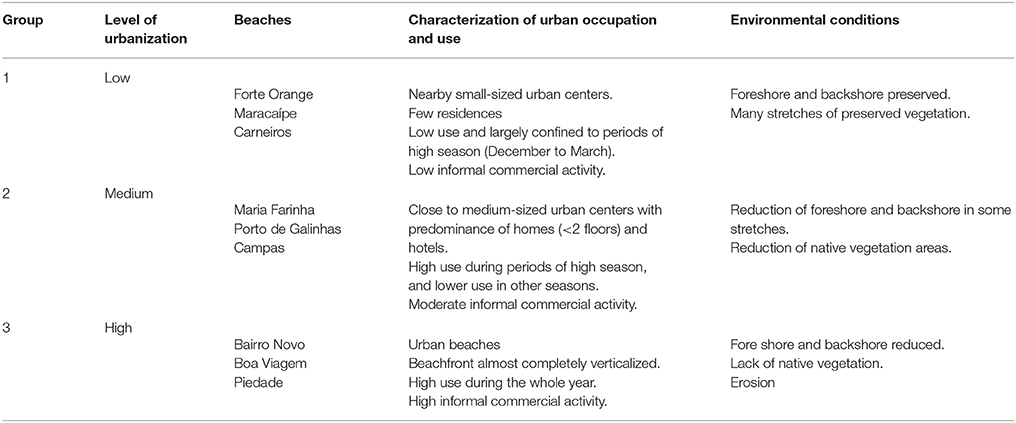
Table 1. Characteristics of the studied beaches based on type of use and occupation of land, which determined the environmental conditions of the studied area (Araújo and Costa, 2008).
The beach groups differed from each other with respect to the level of urbanization, use, and environmental conditions (Table 1).
At each beach, three sections (replicates) measuring 100 × 1 m of the strandline (maximum level reached by the tide and where anthropogenic litter was deposited) were sampled based on Silva-Cavalcanti et al. (2009, 2013) and Jayasiri et al. (2013). The sections were separated by intervals of 100 m. In each section, all items of anthropogenic litter larger than 2 cm were visually counted and classified according to their composition (plastic, glass, metal, paper, wood, and food/organic). Categories were used to identify the most likely sources of anthropogenic litter based on Silva-Iñiguez and Fischer (2003). The categories were beach users, land-based (houses/residences), mixed, and fisheries (Table 2). The category of mixed source included anthropogenic litter of unclear origin (e.g., disposable diapers could be either from beach users or from land-based sources). Cigarette butts were also of uncertain origin because they can be discarded by users on beaches or in urban centers, and can reach the beaches through transportation by urban runoff (Armitage and Rooseboom, 2000; Becherucci and Pon, 2014; Williams et al., 2016).

Table 2. Classification of anthropogenic litter items according to the most likely source (Silva-Iñiguez and Fischer, 2003).
Fragments larger than 2 cm were sampled following the same sample design of the aforementioned categories (100 × 1 m sections). For comparison, a random 10 m stretch of all sections was subsampled for all plastic fragments (0.5–2 cm).
An analysis of variance (ANOVA) was performed to determine the possible differences in the total number of litter items when compared between beach groups. The amount of beach-user related items was then compared between beaches in each group. The premises of normality and homoscedasticity were assumed. Where the ANOVA indicated a significant difference, a Tukey test followed by an HSD test was used to determine which beaches and items were significantly different at the 0.05 level of probability. These analyses were performed using STATISTICA software (Box et al., 2005; Silva-Cavalcanti et al., 2009).
Results
A total of 12,815 items were found on the nine beaches within the three transects on each beach (one survey per beach), with densities (items/m2) of 2.3, 5.7, and 6.3 for groups 1, 2, and 3, respectively. Although the same types of waste occurred on all beaches, the mean amount varied, especially among groups, and increased according to the level of urbanization when considering the total per group (16.3, 39.8, and 43.9% for groups 1, 2, and 3, respectively) (Figure 2).
However, when only the beaches were considered, the largest amounts of anthropogenic litter occurred at Porto de Galinhas (group 2) and Bairro Novo (group 3) beaches, containing 25.4 and 21.4% of litter, respectively. The lowest values were found on Carneiros and Maracaípe beaches (group 1), with 3.3% and 3.1% of litter, respectively (Figure 3). Forte Orange and Bairro Novo presented the largest amounts of residues (60 and 49%, respectively) within their respective groups.
The most-represented items of anthropogenic litter in the evaluated samples were plastic, food/organic, and wood (wooden skewers), which constituted 57.3, 31.4, and 8.5% of the total samples, respectively. Other items accounted for less than 3% of the samples.
With respect to items composed of plastic, the majority were cigarette butts (45%); cigarette butts made up 26% of all anthropogenic litter samples collected.
Possible Sources of Anthropogenic Litter
Items related to beach users were predominant for seven beaches, and were the majority for all the beaches in groups 2 and 3 (Table 3, Figure 4).
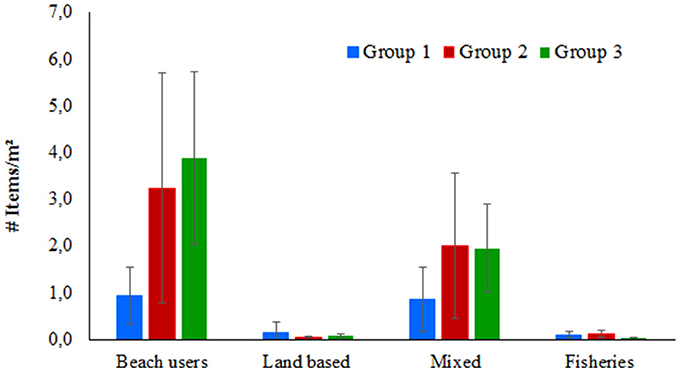
Figure 4. Mean value of items according to their possible source evaluated in the three beach groups.
Porto de Galinhas showed a higher value of litter from beach users than that of the other beaches with higher levels of urbanization (Table 4). The results demonstrated that Porto de Galinhas beach was significantly different from the other beaches in group 2 (p < 0.05), as well as those in group 1 (p < 0.05). However, group 3 beaches (p < 0.05) were similar to Porto de Galinhas beach (p > 0.05) (Tables 3, 4).
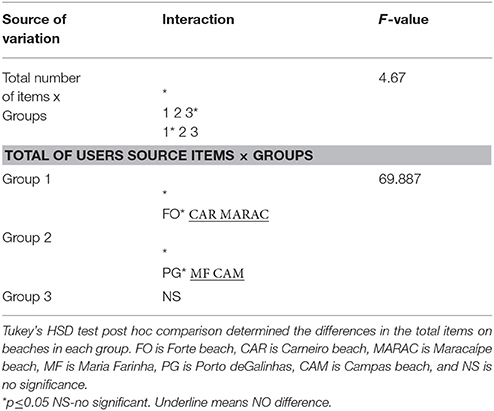
Table 4. Summary of ANOVA analyses for the total number of items, development beach groups, and number of beach users.
In the category of beach-user related litter, 5 types of items (food scraps, wooden skewers, plastic straws, metallized plastic packaging, and lollypop sticks) made up 89.15% of all items of this source. The largest component was food scraps, which comprised 55.66% of all beach-user related litter (Figure 5).
Regarding the land-based source, Forte Orange beach obtained the highest values of items connected to this source, followed by Bairro Novo. Maracaípe and Porto de Galinhas had the lowest amounts. Within the mixed-source category, Porto de Galinhas and Bairro Novo beaches had the highest mean number of items, while Carneiros and Maracaípe beaches had the lowest amounts.
For the fisheries source category, Porto de Galinhas, Campas, and Maracaipe had the highest mean number of items. On the other hand, Boa Viagem and Piedade beaches had the lowest amounts (Table 3).
Evaluation of Plastic Fragments
Fragments larger than 2 cm corresponded to 4.47% of the total items, with 0.40, 0.20, and 0.46 items/m2 for groups 1, 2, and 3, respectively. The largest amounts of fragments for both sizes were found in Forte Orange and Bairro Novo (Figure 6). A larger amount of fragments smaller than 2 cm occurred in all beaches; for this size fraction, the densities were 0.6, 0.5, and 0.76 items/m2 for groups 1, 2, and 3, respectively, which were 1.5, 2.5, and 1.65 times higher, respectively, compared to those of fragments larger than 2 cm.
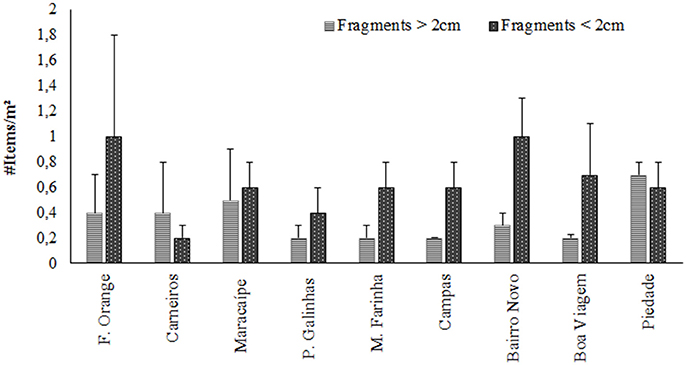
Figure 6. Mean number and standard deviation of plastic fragments found on the strandline at the evaluated beaches.
Discussion
The level of urbanization had an influence on anthropogenic litter abundance, with the amount of anthropogenic litter increasing among the three beach groups. Leite et al. (2014) showed that there was a significant relationship between the proximity to an urban center and the contamination of the studied beaches. Hardesty et al. (2016) also found high debris densities near cities. Becherucci et al. (2017) evaluated the presence of litter on beaches at two locations on the Argentine coast, and noted that the largest proportion of litter occurred on beaches with greater use; according to the results, the amount and composition of the litter were reflections of the recreational use of the beaches. However, Porto de Galinhas presented the largest amount among all beaches, although it belonged to group 2 (medium level of urbanization). Two factors may have contributed to the large amount of anthropogenic litter in Porto de Galinhas. First, this beach is a scenic attraction and the main tourist destination in Pernambuco, with a larger concentration of users than the two other beaches with the same urbanization level, especially during the summer season (November to February). Second, the foreshore and backshore are reduced and are completely occupied by users, thereby favoring an accumulation of anthropogenic litter that is worsened by a poor city cleaning system.
Some factors may have contributed to the large amounts of litter in Forte Orange and Bairro Novo compared with the other beaches in their respective groups. Forte Orange is located on the mouth of an estuary, and thus receives a greater contribution of anthropogenic litter deposited by the tide and waves. When anthropogenic litter is improperly disposed of near watercourse environments, there is a high probability of anthropogenic litter being transported to coastal environments (Araújo and Costa, 2007b). Carneiros is a more isolated beach with access limitations due to the presence of a large number of private lands that prevent the entrance of vehicles and users. Maracaípe is a beach without the protection of beach rocks and with waves that favor surf; thus, it is mainly used by surfers. Therefore, on both beaches (Carneiros and Maracaípe) the amount of users is lower, which reduces the amount of litter generated. Although Bairro Novo also has a high concentration of users, it is distinct from the other beaches in its group (within large cities) because it lacks an efficient system of street cleaning to remove the large amount of anthropogenic litter produced by its users. In contrast, the Boa Viagem and Piedade beaches rely on a system of street cleaning that removes most of the anthropogenic litter. For example, in Boa Viagem, 60 men clean the pavement and the sand strip three times per day by collecting litter (manually and by sweeping), which is then bagged and taken away. At night, sand cleaning is conducted by two tractors with sieves that remove litter up to 20 cm deep. Twenty tons of waste are removed from the beach daily (https://www.recife.pe.gov.br/pr/servicospublicos/emlurb/praiaviva.php).
In relation to the most likely sources of anthropogenic litter assessed, the confirmation that users are primarily responsible for the generation of anthropogenic litter may contribute to the development of actions and strategies aimed at reducing the problem, such as installing bins, installing distribution containers for anthropogenic litter collection, and implementing educational campaigns aimed at beach users.
Although food scraps (the most abundant items related to beach users) degrade faster than other types of anthropogenic litter, they are ideal substrates for the proliferation of pathogenic microorganisms (Zuza-Alves et al., 2016) and serve as a food source for many disease-spreading animals, such as insects, rats, and pigeons (Araújo et al., 2012).
Porto de Galinhas and Campas possess large expanses of sandstone reefs that have a high diversity of organisms (Ferreira et al., 2004; Frédou et al., 2009; Barradas et al., 2010). Thus, these beaches are extensively used for artisanal fishing, which may explain the greater number of items related to fisheries. The presence of these residues in Maracaípe was probably due to its proximity to Porto de Galinhas.
For all beaches, the occurrence of residues unrelated to beach users was likely a consequence of the lack of effective anthropogenic litter management conducted by the municipalities.
With respect to the composition of the litter, plastic was the most abundant material. The high presence of plastic on all evaluated beaches is a pattern that occurs in numerous places in Brazil and other countries (UNEP, 2005, 2009, 2016; Araújo and Costa, 2007a; Ivar do Sul and Costa, 2007, 2013; Moore et al., 2011; Vieira et al., 2011).
Cigarette butts were also abundant, there by demonstrating that this item can be used as a marker of anthropogenic litter pollution level in highly urbanized and/or heavily used beaches. Santos et al. (2005) evaluated the relationship between beach users and anthropogenic litter and quantified the input of tourism-related anthropogenic litter by users with different socio-economic attributes in the southern Brazilian coast. Despite interviewing people that do not usually admit to littering on the beach, they observed that smokers usually leave their cigarette butts in the sand without much concern. Worldwide, the majority of sandy public beaches in tourist areas are also littered with cigarette butts (Novotny and Slaughter, 2014; Scisciolo et al., 2016; Becherucci et al., 2017). According to the International Coastal Cleanup program, which was conducted in 2016, 504,583 volunteers collected 13,840,398 items, of which 1,863,838 were cigarette butts (Ocean Conservancy, 2017)1. The small size and coloration of these items facilitate mixing in with the sand, thereby making it difficult for garbage disposal workers to gather them, which leads to adverse effects on the environment (Ariza et al., 2008; Ariza and Leatherman, 2012; Leite et al., 2014).
The presence of small fragments (<2 cm) in large quantities demonstrated that larger items undergo fragmentation into smaller pieces. Items smaller than 2 cm can still suffer successive breakage and become increasingly smaller items.This fact is potentially impactful, mainly because the small size favors a nearly imperceptible accumulation in the environment; consequently, these fragments persist in the environment for indefinite periods. The size of the residue is directly related to its hazard to animals; the smaller the fragments are, the greater the risk of accidental ingestion or confusing them as food (Galloway, 2015; Lusher et al., 2015).
When ingested, fragments can cause obstruction in the digestive system of the animal or give it a feeling of satiety, which will then reduce its search for food and eventually cause malnutrition and death. There are numerous reports of animals that contained plastic fragments or whole items inside their digestive tracts (Bugoni et al., 2001; Copello and Quintana, 2003; Ivar do Sul and Costa, 2007; Moore, 2008; Possatto et al., 2011; Galloway, 2015; Lönnstedt and Eklöv, 2016; Vendel et al., 2017).
Beach cleaning is costly because it is time-consuming as well as economically expensive. According to Mouat et al. (2010), municipalities throughout the northeast Atlantic region continue to face high costs associated with the removal of anthropogenic litter. UK municipalities spend approximately €18 million each year removing anthropogenic litter, which represents a 37% increase in cost over the past 10 years. Similarly, removing anthropogenic litter costs municipalities in the Netherlands and Belgium approximately €10.4 million per year. Clearly, costs increase with sample area. Therefore, the collection effort must be planned with the goal of saving both economic and human resources.
Planning should establish the minimum effort required to collect data in order to produce satisfactory results, so that the methodology can be repeated with clear and economical ways to manage research activity as well as other research. The choice of representative items (such as cigarette butts) to determine the level of beach pollution can reduce the sampling effort by enabling diagnosis for more extensive areas.
The human component, including attitude toward the environment, is critical for effective anthropogenic litter management. Public awareness and encouraging changes in attitudes related to anthropogenic litter management are essential components in efforts to mitigate the presence of anthropogenic litter in marine and coastal environments.
Author Contributions
MA contributed with study planning and execution, manuscript writting and work coordination. JS-C contributed with field work, samples treatment and statistical analysis. MC made comments to the text and contributed with figures and tables.
Funding
Authors thank CNPq and CAPES for financial support. MC is a CNPq Fellow.
Conflict of Interest Statement
The authors declare that the research was conducted in the absence of any commercial or financial relationships that could be construed as a potential conflict of interest.
Footnotes
1. ^Available online at: http://www.oceanconservancy.org/our-work/international-coastal-cleanup/2016-ocean-trash-index.html (Accessed November 13, 2017).
References
Araújo, M. C. B., and Costa, M. (2006). The significance of solid waste with land-based sources for a tourist beach: Pernambuco, Brazil. Panam. J. Aquat. Sci. 1, 28–34.
Araújo, M. C. B., and Costa, M. (2007a). Visual diagnosis of solid waste contamination of a tourist beach: Pernambuco, Brazil. Beach Manage. 27, 833–839. doi: 10.1016/j.wasman.2006.04.018
Araújo, M. C. B., and Costa, M. (2007b). An analysis of the riverine contribution to the solid waste contamination of an isolated beach at the Brazilian Northeast. Manag. Environ. Qual. 18, 6–12. doi: 10.1108/14777830710717677
Araújo, M. C. B., and Costa, M. F. (2008). Environmental quality indicators for recreational beaches classification. J. Coastal Res. 24, 1439–1449. doi: 10.2112/06-0901.1
Araújo, M. C. B., Silva-Cavalcanti, J. S., and Vicente-Leal, M. M.;, Costa, M. (2012). Análise do comércio formal e informal na Praia de Boa Viagem, Recife, Pernambuco, Brasil. Rev. Gestão Costeira Int. 12, 373–388. doi: 10.5894/rgci329
Ariza, E., Jiménez, J. A., and Sardá, R. (2008). Seasonal evolution of beach waste and anthropogenic litter during the bathing season on the Catalan coast. Waste Manage. 28, 2604–2613. doi: 10.1016/j.wasman.2007.11.012
Ariza, E., and Leatherman, S. P. (2012). No-Smoking Policies and Their Outcomes on U.S. Beaches. J. Coastal Res. 28, 143–147. doi: 10.2112/JCOASTRES-D-10-00137.1
Armitage, N., and Rooseboom, A. (2000). The removal or urban litter from stormwater conduits and streams: Paper 1–The quantities involved and catchment litter management options. Water SA 26, 181–187.
Attademo, F. L. N., Balensiefer, D. C., da Freire, A. C. B., Sousa, G. P., da Cunha, F. A. G. C., and de Luna, F. O. (2015). Debris ingestion by the Antillean Manatee (Trichechusmanatusmanatus). Mar. Pollut. Bull.101, 284–287 doi: 10.1016/j.marpolbul.2015.09.040
Barradas, J. I., Amaral, F. D., Hernández, M. I. M., Flores-Montes, M. J., and Steiner, A. Q. (2010). Spatial distribution of benthic macroorganisms on reef flats at Porto de Galinhas Beach (northeastern Brazil), with special focus on corals and calcified hydroids. Biotemas, 23, 61–67. doi: 10.5007/2175-7925.2010v23n2p61
Becherucci, M. E., and Pon, J. P. S. (2014). What is left behind when the lights go off? Comparing the abundance and composition of litter in urban areas with different intensity of nightlife use in Mar del Plata, Argentina. Waste Manage. 34, 1351–1355. doi: 10.1016/j.wasman.2014.02.020
Becherucci, M. E., Rosenthal, A. F., and Pon, J. P. S. (2017). Marine debris in beaches of the Southwestern Atlantic: an assessment of their abundance and mass at different spatial scales in northern coastal Argentina. Mar. Pollut. Bull. 119, 299–306. doi: 10.1016/j.marpolbul.2017.04.030
Botero, C., Pereira, C., Tosic, M., and Manjarrez, G. (2015). Design of an index for monitoring the environmental quality of tourist beaches from a holistic approach. Ocean Coastal Manage. 108, 65–73. doi: 10.1016/j.ocecoaman.2014.07.017
Box, G. E. P., Hunter, J. S., and Hunter, W. G. (2005). Statistics for Experimenters. 2nd Edn. Wiley Series in Probability and Statistics. Danvers: John Wiley Professional.
Bugoni, L., Krause, L., and Petry, M. V. (2001). Marine debris and human impacts on sea turtles in Southern Brazil. Mar. Pollut. Bull. 42, 1330–1334. doi: 10.1016/S0025-326X(01)00147-3
Coe, J. M., and Rogers, D. B. (2000). Marine Debris: Sources, Impacts and Solutions. New York, NY: Springer, 432.
Copello, S., and Quintana, F. (2003). Marine debris ingestion by Southern Giant Petrels and its potential relationships with fisheries in the Southern Atlantic Ocean. Mar. Pollut. Bull. 46, 1513–1515. doi: 10.1016/S0025-326X(03)00312-6
Corcoran, P. L., and Biesinger, M. C.;, Grifi, M. (2009). Plastics and beaches: a degrading relationship. Mar. Pollut. Bull. 58, 80–84 doi: 10.1016/j.marpolbul.2008.08.022
Debrot, A. O., Tiel, A. B., and Bradshaw, J. E. (1999). Beach debris in Curacao. Mar. Pollut. Bull. 38, 795–801. doi: 10.1016/S0025-326X(99)00043-0
Dias Filho, M. J. O., Araújo, M. C. B., Silva-Cavalcanti, J. S., and Silva, A. C. M. (2011). Contaminação da praia de Boa Viagem (Pernambuco-Brasil) por lixo marinho: relação com o uso da praia. Arqu. Ciências do Mar. 44, 33–39.
Ferreira, C. E. L., Floeter, S., Gasparini, J. L., Ferreira, B. P., and Joyeux, J. C. (2004). Trophic structure patterns of Brazilian reef fishes: a latitudinal comparison. J. Biogeograph. Blackwell 31, 1093–1106. doi: 10.1111/j.1365-2699.2004.01044.x
Frédou, T., Ferreira, B. P., and Letourneur, Y. (2009). Assessing the stocks of the primary snappers caught in Northeastern Brazilian reef systems. 1: traditional modelling approaches. Fish. Res. 99, 90–96. doi: 10.1016/j.fishres.2009.05.008
Galgani, F., Claro, M., and Depledge, C. F. (2014). Monitoring the impact of anthropogenic litter in large vertebratesin the Mediterranean Sea within the European Marine Strategy Framework Directive (MSFD): constraints, specificities and recommendations. Mar. Environ. Res. 100, 3–9. doi: 10.1016/j.marenvres.2014.02.003
Galloway, T. S. (2015). “Micro-and nano-plastics and human health,” in Marine Anthropogenic Litter, eds M. Bergmann, L. Gutow, and M. Klages (Berlin: Springer), 343–366.
Hardesty, B. D., Lawson, T. J., Velde, T. V. D., Lansdell, M., and Wilcox, C. (2016). Estimating quantities and sources of marine debris at a continental scale. Front. Ecol. Environ. 15, 1–55. doi: 10.1002/fee.1447
Ivar do Sul, J. A., and Costa, M. (2007). Marine debris review for Latin America and the Wider Caribbean Region: from the 1970s until now, and where do we go from here? Mar. Pollut. Bull. 54, 1087–1104. doi: 10.1016/j.marpolbul.2007.05.004
IBGE (2011). Atlas geográfico das zonas costeiras e oceânicas do Brasil/IBGE, Diretoria de Geociências. Rio deJaneiro: IBGE. 176. ISBN 978-85-240-4219-5
Ivar do Sul, J. A., and Costa, M. (2013). Plastic pollution risks in an estuarine conservation unit. J. Coastal Res. 65, 48–53. doi: 10.2112/SI65-009.1
Ivar do Sul, J. A., Costa, M. F., Silva-Cavalcanti, J. S., and Araújo, M. C. B. (2014). Plastic debris retention and exportation by a mangrove forest patch. Mar. Pollut. Bull. 78, 252–257. doi: 10.1016/j.marpolbul.2013.11.011
Jayasiri, H. B., Purushothaman, C. S., and Vennila, A. (2013). Plastic litter accumulation on high-water strandline of urban beaches in Mumbai, India. Environ. Monit. Assess. 185, 7709–7719. doi: 10.1007/s10661-013-3129-z
Leite, A. S., Santos, L. L. Y., and Hatje, C. V. (2014). Influence of proximity to an urban center in the pattern of contamination by marine debris. Mar. Pollut. Bull. 81, 242–247. doi: 10.1016/j.marpolbul.2014.01.032
Lithgow, D., Martínez, M. L., and Gallego-Fernández, J. B. (2014). The “ReDune” index(Restoration of coastal Dunes Index) to assess the need and viability of coastal dunerestoration. Ecol. Indicators 49, 178–187. doi: 10.1016/j.ecolind.2014.10.017
Lönnstedt, O. M., and Eklöv, P. (2016). Environmentally relevant concentrations of microplastic particles influence larval fish ecology. Science 352, 1213–1216. doi: 10.1126/science.aad8828
Lozoya, J. P., Sardá, R., and Jiménez, J. A. (2014). Users expectations and the need for differential beach management frameworks along the Costa Brava: Urban vs. natural protected beaches. Land Use Policy 38, 397–414. doi: 10.1016/j.landusepol.2013.12.001
Lusher, A. L., Hernandez-Milian, G., O'Brien, J., Berrow, S., O'Connor, I., and Officer, R. (2015). Microplastic and macroplastic ingestion by a deep diving, oceanic cetacean: the True's beaked whale Mesoplodon mirus. Environ. Pollut. 199:185–191. doi: 10.1016/j.envpol.2015.01.023
Marshall, F. E., Banks, K., and Cook, G. S. (2014). Ecosystem indicators for Southeast Florida beaches. Ecol. Indic. 44, 81–91. doi: 10.1016/j.ecolind.2013.12.021
Mendes, S. S., Carvalho, R. H., Faria, A. F., and de Sousa, B. M. (2015). Marine debris ingestion by Cheloniamydas (Testudines: Cheloniidae) on the Brazilian coast. Mar. Poll. Bull. 92, 8–10. doi: 10.1016/j.marpolbul.2015.01.010
Moore, C. J. (2008). Synthetic polymers in the marine environment: a rapidly increasing, long-term threat. Environ. Res. 108, 131–139. doi: 10.1016/j.envres.2008.07.025
Moore, C. J., Lattin, G. L., and Zellers, A. F. (2011). Quantity and type of plastic debris flowing from two urban rivers to coastal waters and beaches of Southern California.Revista da Gestão Costeira Integrada, 11, 65–73. doi: 10.5894/rgci194
Mouat, T., Lopez-Lozano, R., and Bateson, H. (2010). Economic Impacts of Anthropogenic Litter. Lerwick: Kommunenes Internasjonale Miljøorganisasjon (KIMO).
Nelson, C., and Botterill, D. (2002). Evaluating the contribution of the beach quality awards to the local tourism industry in Wales–The Green Coast Award. Ocean Coastal Manage. 45, 157–170. doi: 10.1016/S0964-5691(02)00053-4
Novotny, T., and Slaughter, E. (2014). Tobacco product waste: an environmental approach to reduce tobacco consumption. Curr. Environ. Health Rep. 1, 208–216. doi: 10.1007/s40572-014-0016-x
Oh, C.-O., Draper, J., and Dixon, A. W. (2010). Comparing resident and tourist preferences for public beach access and related amenities. Ocean Coastal Manage. 53, 245–251. doi: 10.1016/j.ocecoaman.2010.04.007
Pasquini, G., Ronchi, F., Strafella, P., Scarcella, G., and Fortibuoni, T. (2016). Seabed litter composition, distribution and sources in the Northern and Central Adriatic Sea (Mediterranean). Waste Manage. 58, 41–51. doi: 10.1016/j.wasman.2016.08.038
Paula, D. P., Dias, J. M. A., Ferreira, Ó., and Morais, J. O. (2013). High-rise development of the sea-front at Fortaleza (): Perspectives on its valuation and consequences. Ocean Coastal Manage. 77, 14–23. doi: 10.1016/j.ocecoaman.2012.03.004
Pendleton, L., Martin, N., and Webster, D. G. (2001). Public perceptions of environmental quality: a survey study of beach use and perceptions in Los Angeles County. Mar. Pollut. Bull. 42, 1155–1160. doi: 10.1016/S0025-326X(01)00131-X
Possatto, F. E., Barletta, M., Costa, M. F., Ivar do Sul, J. A., and Dantas, D. V. (2011). Plastic debris ingestion by marine catfish: an unexpected fisheries impact. Mar. Pollut. Bull. 62, 1098–1102. doi: 10.1016/j.marpolbul.2011.01.036
Santos, I. R., Friedrich, A. C., Wallner-Kersanach, M., Fillmann, G., Shiller, R. V., and Costa, R. (2003). Geração de resíduos sólidos pelos usuários da praia do Cassino, RS, Brasil. Rev. Gestão Int. Países de Língua Portuguesa 3, 12–14.
Santos, I. R., Friedrich, A. C., Wallner, M., and Fillmann, G. (2005). Influence of socio-economic characteristics of beach users on anthropogenic litter generation. Ocean Coastal Manage. 48, 742–752. doi: 10.1016/j.ocecoaman.2005.08.006
Scisciolo, T., de Mijts, E. N., Becker, T., and Eppinga, M. B. (2016). Beach debris on Aruba, Southern Caribbean: attribution to local land-based and distal marine-based sources. Mar. Pollut. Bull. 106, 49–57. doi: 10.1016/j.marpolbul.2016.03.039
Silva, I. R., Pereira, L. C. C., Trindade, W. N., Magalhães, A., and Costa, R. M. (2013). Natural and anthropogenic processes on the recreational activities in urban Amazon beaches. Ocean Coastal Manage. 76, 75–84. doi: 10.1016/j.ocecoaman.2012.12.016
Silva, J. S., Barbosa, S. C. T., and Costa, M. F. (2008). Flag Items as a tool for monitoring solid anthropogenic litters from users on urban beaches. J. Coastal Res. 24, 890–898. doi: 10.2112/06-0695.1
Silva, M. L., da; Araújo, F. V., de; Castro, R. O., and Sales, A. S. (2015). Spatial–temporal analysis of marine debris on beaches of Niterói, RJ, Brazil: itaipu and Itacoatiara. Mar. Pollut. Bull. 92, 233–236. doi: 10.1016/j.marpolbul.2014.12.036
Silva, M. L., Sales, A. S., Martins, S., Castro, R.O., and Araújo, F.V. (2016). The influence of the intensity of use, rainfall and location in the amount of marine debris in four beaches in Niteroi, Brazil: Sossego, Camboinhas, Charitas and Flechas. Mar. Pollut. Bull. 113, 36–39. doi: 10.1016/j.marpolbul.2016.10.061
Silva-Cavalcanti, J. S., Araujo, M. C. B., and Costa, M. (2009). Plastic anthropogenic litter on an urban beach – a case study in Brazil. Waste Manage. Res. 27, 93–97. doi: 10.1177/0734242X08088705
Silva-Cavalcanti, J. S., Araújo, M. C. B., and Costa, M. (2013). Medium-term patterns and trends of solid waste contamination on the beach of Boa Viagem, Northeast Brazil. Q. Environ. Geosci. 4, 17–24.
Silva-Iñiguez, L., and Fischer, D. W. (2003). Quantification and classification of marine anthropogenic litter on the municipal beach of Ensenada, Baja California, Mexico. Mar. Pollut. Bull. 46, 132–135. doi: 10.1016/S0025-326X(02)00216-3
Thompson, R. C., Swan, S. H., Moore, C. J., and Vom Saal, F. S. (2009). Our plastic age. Phil. Trans. R. Soc. B 364, 1–4. doi: 10.1098/rstb.2009.0054
Tran, K. C., Euan, J., and Isla, M. L. (2002). Public perception of development issues: impact of water pollution on a small coastal community. Ocean Coastal Manag. 45, 405–420. doi: 10.1016/S0964-5691(02)00077-7
Tudor, D. T., and Williams, A. T. (2006). A rationale for beach selection by the public on the coast of Wales. Area 38, 153–164. doi: 10.1111/j.1475-4762.2006.00684.x
UNEP (2016). Marine Plastic Debris and Microplastics–Global Lessons and Research to Inspire Action and Guide Policy Change. Nairobi: United Nations Environment Programme.
Vendel, A. L., Bessa, F., Alves, V. E., N; Amorim, A. L. A., Patrício, J., and Palma, A. R. T. (2017). Widespread microplastic ingestion by fish assemblages in tropical estuaries subjected to anthropogenic pressures. Mar. Poll. Bull. 117, 448–455. doi: 10.1016/j.marpolbul.2017.01.081
Vieira, B. P., Dias, D., and Hanazaki, N. (2011). Homogeneidade de encalhe de resíduos sólidos em um manguezal da Ilha de Santa Catarina, Brasil. Rev. Gestão Costeira Int. 11, 21– 30. doi: 10.5894/rgci188
Williams, A. T., Randerson, P., Di Giacomo, C., Anfuso, G., Macias, A., and Perales, J. A. (2016). Distribution of beach litter along the coastline of Cádiz, Spain. Mar. Pollut. Bull. 107, 77–87 doi: 10.1016/j.marpolbul.2016.04.015
Williams, A. T., and Simmons, S. L. (1997). Movement patterns of riverine litter. Water Air Soil Poll. 98, 119–139. doi: 10.1007/BF02128653
Williams, A. T., and Simmons, S. L. (1999). Sources of riverine litter. The River Taff, South Wales, UK. Water Air Soil Pollut. 112, 197–216. doi: 10.1023/A:1005000724803
Wilson, S. P., and Verlis, K. M. (2017). The ugly face of tourism: marine debris pollution linked to visitation in the southern Great Barrier Reef, Australia. Mar. Poll. Bull. 117, 239–246. doi: 10.1016/j.marpolbul.2017.01.036
Zuanazzi, P. T. (2016). Estimativas Para a População Flutuante do Litoral Norte do RS / Pedro TononZuanazzi, Mariana Bartels. Porto Alegre: FUNDAÇÃO DE ECONOMIA E ESTATÍSTICA (FEE).
Zuza-Alves, D. L., Medeiros, S. S. T., Souza, L. B. F. C., Silva-Rocha, W. P., Francisco, E. C., Araújo, M. C. B., et al. (2016). Evaluation of virulence factors in vitro, resistance to osmotic stress and antifungal susceptibility of Candida tropicalis isolated from the coastal environment of northeast Brazil. Front. Microbiol. 7:1783. doi: 10.3389/fmicb.2016.01783
Keywords: coastal environments, marine pollution, marine litter, plastic litter, beach users
Citation: Araújo MCB, Silva-Cavalcanti JS and Costa MF (2018) Anthropogenic Litter on Beaches With Different Levels of Development and Use: A Snapshot of a Coast in Pernambuco (Brazil). Front. Mar. Sci. 5:233. doi: 10.3389/fmars.2018.00233
Received: 12 September 2017; Accepted: 15 June 2018;
Published: 09 July 2018.
Edited by:
Cristina Panti, University of Siena, ItalyReviewed by:
Christos Ioakeimidis, United Nations Environment Programme Mediterranean Action Plan (UNEP/MAP), GreeceSabine Rech, Universidad de Oviedo, Spain
Copyright © 2018 Araújo, Silva-Cavalcanti and Costa. This is an open-access article distributed under the terms of the Creative Commons Attribution License (CC BY). The use, distribution or reproduction in other forums is permitted, provided the original author(s) and the copyright owner(s) are credited and that the original publication in this journal is cited, in accordance with accepted academic practice. No use, distribution or reproduction is permitted which does not comply with these terms.
*Correspondence: Maria C. B. Araújo, bWNiYXJhdWpvQHlhaG9vLmNvbS5icg==
 Maria C. B. Araújo1*
Maria C. B. Araújo1* Jacqueline S. Silva-Cavalcanti
Jacqueline S. Silva-Cavalcanti Monica F. Costa
Monica F. Costa